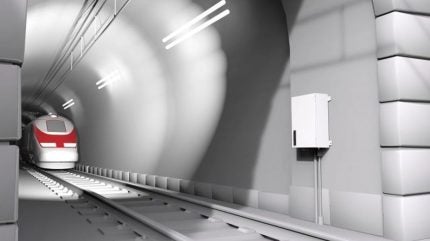
A landmark rail project in Stuttgart, Germany, is heralding a new standard for rail infrastructure in Europe and possibly even worldwide. More than a decade in the making, the €7 billion Stuttgart-Ulm – or Stuttgart 21 – rail project, one of the most complex in modern times, comprises a fundamental reorganising of the rail node on the busy east-west main line from Paris to Budapest.
Apart from four new stations, it will create 35 miles of high-speed tracks and equip the city’s S-Bahn trains with European Rail Traffic Management System (ERTMS) Automatic Train Operation (ATO) digital signalling technology for the first time in Germany. More than 200 regional trains will also be retrofitted with this signalling and train operating technology, some of the most sophisticated outside Asia and the Middle East.
It includes point machines providing electrohydraulic rail switch control, axel counters that detect whether sections of track are clear or occupied, and other sensors essential to the safe, smooth and reliable operation of services at the station.
Eyes on the future
Once live, the new lines are anticipated to save more than 620 million miles of car journeys a year and transform connectivity for those travelling across Europe. Capacity is a major challenge, and the digitisation of this critical railway junction is intended to increase the performance of train flow across the network and create the basis for future upgrades of traffic and incident management systems. As the ERTMS stipulates that signalling and speed control systems across Europe must be consistent to ensure interoperability, it is anticipated that the technology used for the signalling and train control systems at Baden-Württemberg will be eventually rolled out across Europe and maybe even further afield.
But how will these critical digital systems, which will be housed in enclosures along the track, be protected from vicious cyber criminals? Digitisation is often associated with data being passed through the cloud and the cyber threat assumed to be the potential for attack on these digital networks. But there is a physical aspect that doesn’t get as much attention.
The critical electronics systems controlling the modern railway system run alongside the tracks and are also stored in cabinets beside stations. While the fibre optic cables transmitting digital information are worthless in themselves, hackers with basic technical knowledge can break into the cabinets containing them and use a simple LG45 cable and a laptop to connect to the system and control the trains. In a worst-case scenario, poorly protected digital infrastructure could be exploited by bad actors to incite head-on collisions, with potentially disastrous results given modern high-speed trains are capable of travelling at 400 miles per hour.
“The computer is the entry for hackers into the railroad system- a big change between the old technology and the new technology,” explains Olivier Haven, global key account manager for nVent SCHROFF, which is providing the trackside enclosures for the Stuttgart 21 project.
Brendan Quinn, nVent SCHROFF enterprise rail leader adds: “Somebody has to actually build something for the software to work on, and somebody has to physically secure the systems that run the software.”
The physical aspect of protecting digital rail infrastructure
Protecting the digital rail system from cyber threats is all the more important given the rising number of trains across networks. Net-zero targets and environmentally conscious consumers are driving the ever-increasing popularity of rail as a method of transport. Operators and governments also aspire for trains to depart at higher frequencies to cope with rising demand. On top of this, ERTMS standards in Europe mean operators must ensure cross-continental trains can pass borders with ease.
The electromagnetic environment of the railway is further complicated by the multiple cellular networks operating in parallel, from passengers using 5G to scroll social media to the digital signalling systems and sensors tied to predictive maintenance on the tracks. With such a dense proliferation of electronics in the railway environment, shielding from electromagnetic interference is essential. Operators need to invest in the right equipment to protect the digital railway from disturbance and attack.
Fortunately, new solutions are being developed to future-proof the modern railway network, notably, nVent SCHROFF’s state-of-the-art electronics enclosures. Their adaptable, resilient cabinets are already being used in destinations in Europe, Asia, and North America to control both freight and passenger operations.
“Apart from vandalism and cyber hacks, our cabinets are designed to withstand the harsh environment on trackside and in tunnels. Lightning strikes and high temperatures, as well as the encroachment of dust, can compromise performance. nVent SCHROFF’s offering shields the systems from external weather events, through passive cooling or with air conditioning units installed within to maintain optimum internal temperatures,” says Haven.
“They meet stringent grounding, trackside shock, and vibration standards and they are also easy to install to help meet project deadlines.”
Quinn stresses the importance of OEMs working on rail upgrade projects to appreciate the significance of enclosure innovation to its ultimate success: “Billions of euros will be spent over the next ten to 15 years on upgrading rail infrastructure and using technology to increase the train flow, optimise incident management and improve the flow of data between stations, but up there at the top of that list must also be robust physical protection of the ‘brain’ of the train network so that passenger safety is never compromised. “


